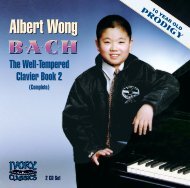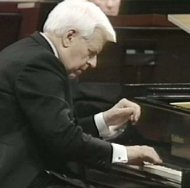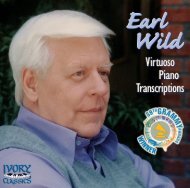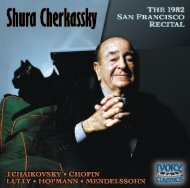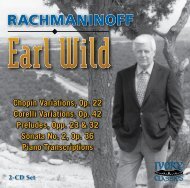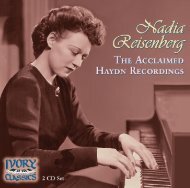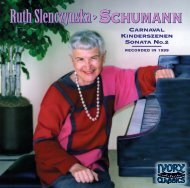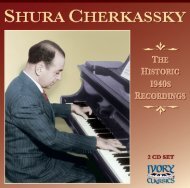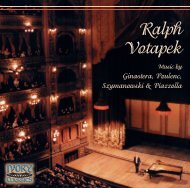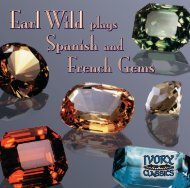Earl Wild Goes To The Movies - Ivory Classics
Earl Wild Goes To The Movies - Ivory Classics
Earl Wild Goes To The Movies - Ivory Classics
You also want an ePaper? Increase the reach of your titles
YUMPU automatically turns print PDFs into web optimized ePapers that Google loves.
<strong>Earl</strong> <strong>Wild</strong> <strong>Goes</strong> <strong>To</strong> <strong>The</strong> <strong>Movies</strong><br />
Music by Rodgers/<strong>Wild</strong>, Rózsa, Liszt, Chopin, Steiner, and Mozart<br />
Music on the screen can seek out and intensify the inner thoughts of the characters.<br />
It can invest a scene with terror, grandeur, gaiety or misery. It often lifts mere dialogue<br />
into the realm of poetry. It is the communicating link between screen and audience,<br />
reaching out and enveloping all into one single experience.<br />
— Bernard Herrmann<br />
Although it can be argued that music written for films serves a utilitarian or cosmetic<br />
role – largely as continuity or support of the visual – there is much film music<br />
that outlives the film it was written for. As the history of film has evolved, so has the<br />
history of film music. From the primitive days of pianistic improvisation for silent<br />
cinema to today’s extraordinary and complex scores, audiences have been regaled<br />
by musical creativity of astonishing proportions. Some of the greatest classical composers<br />
wrote film scores – Sergei Prokofiev, Ralph Vaughan Williams, William<br />
Walton, Dmitri Shostakovich, Aram Khachaturian, Arthur Honegger, <strong>To</strong>ru Takemitsu,<br />
Virgil Thomson, Darius Milhaud and Aaron Copland. Hollywood also created a status<br />
and prestige to film composing, generating a formidable group of musicians who<br />
are largely know today for their extraordinary cinematic scores. <strong>The</strong>se include Erich<br />
Wolfgang Korngold, Alfred Newman, Franz Waxman, Dimitri Tiomkin, Bernard<br />
Herrmann, Alex North, Elmer Bernstein, Leonard Rosenman, Roy Webb, Max Steiner<br />
and Miklós Rózsa. In most cases, these composers lived a double life – their<br />
Hollywood or cinematic career, and their concert hall and stage career, creating<br />
music in both arenas. <strong>Earl</strong> <strong>Wild</strong>’s program of piano concerti from the cinema, features<br />
three works written expressly for the screen and three works adapted from the<br />
concert stage as part of the films’ tapestries.<br />
Richard Rodgers (1902-1979) is largely remembered today for his fabulous musicals<br />
(in collaboration with Oscar Hammerstein II and Lorenz Hart): Babes in Arms<br />
(1937), Pal Joey (1940), Oklahoma! (1943), Carousel (1945), South Pacific (1949), <strong>The</strong><br />
King and I (1951) and <strong>The</strong> Sound of Music (1959). On Your <strong>To</strong>es (1936), based on the<br />
– 2 –
<strong>Earl</strong> <strong>Wild</strong>, 1947<br />
– 3 –
successful George Abbot play about an American composer/dancer who is mistaken<br />
for a traitor by a visiting Russian ballet company, featured Rodgers’ first extensive<br />
orchestral music for ballet sequences, choreographed by George Balanchine. <strong>The</strong><br />
most famous sequence was Slaughter on Tenth Avenue. <strong>The</strong> 1936 Broadway production<br />
featured Ray Bolger and Tamara Geva. <strong>The</strong> ballet had a comic emphasis when<br />
On Your <strong>To</strong>es was made into a film musical in 1939 (featuring Eddie Albert, Vera<br />
Zorina and Donald O’Connor). When Rodgers revised the score for the 1957 movie<br />
entitled Slaughter on Tenth Avenue, featuring Richard Egan, Jan Sterling, Dan<br />
Composers George Antheil, Eugene Zador, Arthur Bergh, Italo Montemezzi, Miklós Rósza,<br />
Richard Hageman, William Grant Still, Igor Stravinsky, Ernst <strong>To</strong>ch, Louis Gruenberg,<br />
Erich Wolfgang Korngold attending a Hollywood Bowl dinner, July 1948<br />
– 4 –
<strong>Earl</strong> <strong>Wild</strong> with<br />
Radio City Rockettes, 1984<br />
Duryea, Julie Adams and<br />
Walter Matthau, the<br />
music, as background to a<br />
story about waterfront<br />
racketeering, was turned<br />
into a steamy melodrama.<br />
In 1965 <strong>Earl</strong> <strong>Wild</strong> was<br />
asked to rewrite the ballet<br />
music. He added a jazztinged<br />
piano score and reorchestrated<br />
parts of the<br />
work, resulting in a fastpaced,<br />
exciting piano concertino,<br />
full of drama and<br />
sassy musicality.<br />
Max Steiner (1888-1971) was born into a prominent Viennese musical family<br />
(his godfather was Richard Strauss). He conducted musical comedy in Paris,<br />
Berlin, and Moscow before coming to Broadway in 1914. In 1929 he moved to<br />
Hollywood. As a result of Steiner’s efforts and prodigious productivity,<br />
Hollywood began to value original composition as background scoring for the<br />
movies. He became one of the most prolific composers in Hollywood. His<br />
incredible full score to King Kong (1933) brought original film music into a new<br />
era. After, RKO Steiner joined Warners, beginning with his score for <strong>The</strong> Charge<br />
of the Light Brigade (1936). During the next ten years he averaged writing music<br />
for eight major films a year! In 1939 he wrote three hours of music for the epic<br />
Gone With <strong>The</strong> Wind, as well as providing music for another eleven films. Steiner<br />
scored his last film in 1965, resentful that he was forced to retire at 77 years of<br />
age, when he felt that he had so much more music in him. Without a doubt, he<br />
was the last of the great film composers of the golden age of Hollywood.<br />
Steiner composed his mini-concerto, Symphonie Moderne for the 1939 film,<br />
Four Wives. <strong>The</strong> film starred Claude Rains, Eddie Albert, Priscilla Lane,<br />
– 5 –
<strong>Earl</strong> <strong>Wild</strong> recording in London, August 19, 1965<br />
– 6 –
Rosemary Lane, Lola Lane, Gale Page and John Garfield in what was a sequel to the<br />
1938 film, Four Daughters.<br />
Miklós Rózsa (1907-1995) was born in Budapest. He graduated from the Leipzig<br />
Conservatory cum laude, and saw the premiere of his First Violin Concerto and the<br />
publication of his String Trio, Opus 1 before moving to London in 1935. <strong>The</strong>re he<br />
began writing music for a number of Sir Alexander Korda’s films eventually moving<br />
to America in 1940. He settled in Hollywood where he continued writing for the films<br />
and teaching at the University of Southern California. He won the Academy Award<br />
three times — for Spellbound (1945), A Double Life (1948) and for Ben-Hur (1959). He<br />
entitled his autobiography, Double Life, because in parallel with his Hollywood creations,<br />
Rózsa was always actively composing non-film music. Among his other<br />
works are the Concerto for Strings (1943), the Piano Sonata (1949), and the Violin<br />
Concerto (1953, composed for, premiered and recorded by Jascha Heifetz). Without<br />
a doubt, one his best known works remains the Spellbound Concerto. It was written<br />
for the 1945 Alfred Hitchcock film, starring Ingrid Bergman, Gregory Peck, Leo G.<br />
Carroll, John Emery and Rhonda Fleming. Rózsa recalled that “in Spellbound<br />
Salvador Dali’s designs for the central dream-interpretation sequence immediately<br />
suggested a musical complement, and literally colored my concept of the score as a<br />
whole.” <strong>To</strong> create a musical sound-picture of Gregory Peck’s amnesia-paranoia,<br />
Rózsa utilized one of the earliest electronic musical instruments, the theremin,<br />
which was invented by Russian scientist, Léon Thérémin in 1919 and patented in the<br />
USA in 1927. Since the theremin has a vertiginous, swooning sound quality, the four<br />
dream-sequences in the movie contain some of the most compelling and original<br />
film music ever written. In this 1965 recording, the London Promenade Orchestra<br />
used a theremin, which is not typically the norm in recordings today.<br />
In his autobiography, Miklós Rózsa wrote, “I have always tried in my work to<br />
express human feelings, assert human values... tonality means line; line means<br />
melody; melody means song, and song, especially folksong, is the essence of music<br />
because it is the natural, spontaneous and primordial expression of human emotion.”<br />
When original film scores were not called for, Hollywood (and the film<br />
producers around the world) relied on the well-tested music of the classics. <strong>The</strong><br />
music of Chopin and Liszt became perennial favorites, to be used when passion and<br />
romance was on the screen. Chopin’s was portrayed by Pierre Blanchar in a silent<br />
– 7 –
film directed in 1927 by Henry Roussel entitled La valse de l’adieu. In 1934 Jean<br />
Servais played the composer in a film directed by Géza von Bolvary, entitled<br />
Abschiedswalzer. Perhaps the best known treatment of Chopin’s life (albeit somewhat<br />
romanticized and superficial) is the Charles Vidor film of 1944, A Song to<br />
Remember, starring Cornel <strong>Wild</strong>e, Merle Oberon and Paul Muni. Chopin’s music was<br />
performed by José Iturbi and the scoring of the music in the film garnered an<br />
Academy Award. In 1952 the Polish director, Aleksander Ford produced a film featuring<br />
Czeslaw Wollejko as Chopin. <strong>The</strong> film, entitled Young Chopin, featured also<br />
works of Bach, Mozart, Paganini and Lanner. In 1957 the French filmmaker and<br />
historian, Jean Mitry created a film short, Chopin, which featured performances by<br />
Witold Malcuzynski. Chopin’s music was also featured in the following films:<br />
Jutrzenka: A Winter in Majorca (1971); La Note bleue (1991) which explored the passion<br />
between Chopin and Sand; and L’innocente (1976), a Luchino Visconti film for<br />
which Franco Mannino played and conducted the music of Chopin and Liszt.<br />
Although Chopin’s music was not used in the 1945 film Un ami viendra ce soir, the<br />
French composer Arthur Honegger was commissioned to write a piano piece in the<br />
style of Chopin, resulting in the delightful piece of pianistic fluff entitled Souvenir de<br />
Chopin. Liszt’s music has also been featured in a number of films, including the 1957<br />
tearjerker Interlude (with June Allyson and Rossano Brazzi); Lisztomania, the outlandish<br />
Ken Russell extravaganza from 1975 starring Roger Daltrey, Sara Kestelman,<br />
Paul Nicholas, Fiona Lewis and Ringo Starr; the 1934 Franz Osten film, Rhapsodie, in<br />
which Liszt is portrayed by Wolfgang Liebeneiner; and the lavish Charles<br />
Vidor/George Cukor 1960 film, Song Without End, starring Dirk Bogarde, Genevieve<br />
Page, Patricia Morison and Lou Jacobi. In Song Without End, Liszt’s music is superbly<br />
interpreted by Jorge Bolet.<br />
Like his Romantic colleagues, Wolfgang Amadeus Mozart was not ignored by the<br />
film industry. Mozart’s life and music have been the subject of inspection in more<br />
than two dozen films, including Mozart (Whom the Gods Love) (1936) with John<br />
Loder, Victoria Hopper and Liane Haid; Wen die Götter lieben (1942), a film by Karl<br />
Hartl, featuring Hans Holt as Mozart; Unsterbilcher Mozart (1954) directed by Alfred<br />
Stöger; and most recently, the exquisitely filmed, Amadeus (1984), directed by Milos<br />
Forman, starring F. Murray Abraham and <strong>To</strong>m Hulce. Mozart’s music has been<br />
resplendently featured in many other films, including the Jean Renoir masterpieces,<br />
– 8 –
Russell Stanger and <strong>Earl</strong> <strong>Wild</strong>, Chopin recording session, May 10, 1963<br />
La Marseillaise (1939) and Le règle du jeu (1939); the Robert Bresson film Un<br />
condamné à mort s’est échappé (1957); and the 1967 Swedish film, Elvira Madigan,<br />
which featured a lush interpretation of the second movement of Mozart’s Piano<br />
Concerto No.21 in C Major, K.467 played by Géza Anda. <strong>The</strong> film was a big hit in its<br />
time, but thirty years later what only remains is the memory of Mozart’s haunting<br />
music which was so effectively used in the film. <strong>To</strong> the consternation of musical<br />
purists, many recordings of Mozart’s concerto simply title it the “Elvira Madigan”<br />
concerto as it has become known in popular culture.<br />
– Marina and Victor Ledin, ©1998<br />
– 9 –
<strong>Earl</strong> <strong>Wild</strong> Biography<br />
<strong>Earl</strong> <strong>Wild</strong> is a pianist in the grand Romantic tradition. His career, so distinguished<br />
and long has continued for over 70 years. Born in 1915, in Pittsburgh, Pennsylvania,<br />
<strong>Earl</strong> <strong>Wild</strong>’s technical accomplishments are often likened to what those of Liszt himself<br />
must have had. Born with absolute pitch he started playing the piano at 3 years<br />
old. Having studied with great pianists such as Egon Petri, his lineage can be traced<br />
back to Scharwenka, Busoni, Ravel, d’Albert and Liszt himself.<br />
<strong>The</strong> <strong>Wild</strong> career is dotted with musical legends. As a young pianist he was soloist<br />
with Arturo <strong>To</strong>scanini. Since then he has performed with virtually every major conductor<br />
and symphony orchestra in the world. Rachmaninov was his friend and<br />
important idol in his life. It has been said of <strong>Earl</strong> <strong>Wild</strong>. “He’s the incarnation of<br />
Rachmaninov, Lhevinne and Rosenthal rolled into one!” In 1986 after hearing him<br />
play three sold-out Carnegie Hall concerts, devoted to Liszt, honoring the centenary<br />
of that composer’s death, one critic said, “I find it impossible to believe that he<br />
played those millions of notes with 70-year-old fingers, so fresh-sounding and precise<br />
were they. Perhaps he has a worn-out set up in his attic, a la Oscar <strong>Wild</strong>e’s<br />
‘Picture of Dorian Gray.’”<br />
As an American pianist, he is only one of a handful to have achieved international<br />
and domestic celebrity. He’s performed for six Presidents of the United States, and<br />
in 1939, was the first classical pianist to give a recital on the new medium of television.<br />
At fourteen he was performing in the Pittsburgh Symphony with Otto Klemperer<br />
as well as working at radio station KDKA playing all the major repertoire as well as his<br />
own compositions. As a virtuoso pianist, composer, transcriber, conductor, editor<br />
and teacher, <strong>Earl</strong> <strong>Wild</strong> continues in the style of the great artists of the past.<br />
This eminent pianist has built an extensive repertoire, which includes both standard<br />
and modern literature and has won renown in particular for his brilliant performances<br />
of the virtuoso Romantic works.<br />
<strong>To</strong>day at 82, Mr. <strong>Wild</strong> continues to record CDs on a regular basis and perform<br />
concerts around the world. In 1997, he won a GRAMMY ® Award for Best Instrumental<br />
Soloist Performance (without Orchestra) for his CD entitled, <strong>The</strong> Romantic Master -<br />
13 piano transcriptions on the Sony Classical label. When he was 79 he recorded a<br />
well received Beethoven disc which included the very difficult ‘Hammerklavier’<br />
– 10 –
Sonata, as well as a disc of the complete Rachmaninov Preludes. Now an exclusive<br />
IVORY CLASSICS artist, his immediate plans are to record four 20th century piano<br />
sonatas by well known composers as well as a sonata of his own.<br />
Credits<br />
Rodgers/<strong>Wild</strong>: Slaughter on Tenth Avenue was recorded in London, August 19, 1965<br />
Steiner: Symphonie Moderne was recorded in London in April 1965<br />
Liszt: Un Sospiro was recorded in London in April 1967<br />
Rózsa: Spellbound Concerto was recorded in London, August 19, 1965<br />
Chopin: Grande Polonaise Brillante, Opus 22 was recorded in London, May 10, 1963<br />
Mozart: Piano Concerto No.21 in C Major, K.467, was recorded in London, April 3, 1982.<br />
Licensed from Reader's Digest Music,<br />
A Division of the Reader's Digest Association, Inc.<br />
Original Recording Engineer: Kenneth G. Wilkinson [Tracks 1-5]<br />
Remastering Producer: Michael Rolland Davis<br />
High Resolution Digital Remastering:<br />
Ed Thompson and Glenn Meadows at Masterfonics, Nashville<br />
®<br />
encoding provided by Doug Beard and <strong>To</strong>m Jenny of Data CD, Inc.<br />
Special Thanks to Audio Encounters; Dublin, Ohio<br />
Liner Notes: Marina and Victor Ledin • Design: Communication Graphics<br />
Photo of Eva Gabor and <strong>Earl</strong> <strong>Wild</strong>, Palm Springs, CA, 1969<br />
<strong>To</strong> be included on mailing list, or receive information on <strong>Ivory</strong> <strong>Classics</strong> , contact:<br />
<strong>Ivory</strong> <strong>Classics</strong> <br />
P.O. Box 341068 • Columbus, Ohio 43234-1068 • Phone: 1-888-40-IVORY<br />
e-mail@ivoryclassics.com • Website: http://www.<strong>Ivory</strong><strong>Classics</strong>.com<br />
– 11 –
<strong>Earl</strong> <strong>Wild</strong> <strong>Goes</strong> <strong>To</strong> <strong>The</strong> <strong>Movies</strong><br />
Music by Rodgers/<strong>Wild</strong>, Rózsa, Liszt, Chopin, Steiner and Mozart<br />
1<br />
Richard Rodgers/<strong>Earl</strong> <strong>Wild</strong>: Slaughter on Tenth Avenue (1936/1957) 9:11<br />
2<br />
<strong>Earl</strong> <strong>Wild</strong>, Pianist • London Promenade Orchestra • Harry Rabinowitz, Conductor<br />
Max Steiner: Symphonie Moderne (1939) 8:12<br />
3<br />
<strong>Earl</strong> <strong>Wild</strong>, Pianist (and Celeste) • RCA Symphony Orchestra • Eric Hammerstein, Conductor<br />
Franz Liszt: Un Sospiro (Étude No.3 in D flat) 5:30<br />
4<br />
<strong>Earl</strong> <strong>Wild</strong>, Pianist • Gamley Orchestra • Douglas Gamley, Conductor<br />
Miklós Rózsa: Spellbound Concerto (1945) 8:00<br />
5<br />
<strong>Earl</strong> <strong>Wild</strong>, Pianist • London Promenade Orchestra • Charles Gerhardt, Conductor<br />
Fryderyk Chopin: Grande Polonaise Brillante, Opus 22 8:31<br />
<strong>Earl</strong> <strong>Wild</strong>, Pianist • Royal Philharmonic Orchestra • Russell Stanger, Conductor<br />
Wolfgang Amadeus Mozart: Piano Concerto No.21 in C Major, K.467 (“Elvira Madigan”) 28:06<br />
<strong>Earl</strong> <strong>Wild</strong>, Pianist • Royal Philharmonic Orchestra • Anthony Randall, Conductor<br />
6<br />
I. Allegro maestoso (Cadenza by <strong>Earl</strong> <strong>Wild</strong>) 14:40<br />
7<br />
II. Andante 7:03<br />
8<br />
III. Allegro vivace assai (Cadenzas by <strong>Earl</strong> <strong>Wild</strong>) 6:23<br />
<strong>To</strong>tal Playing Time: 68:00<br />
Original Recording Engineer: Kenneth G. Wilkinson [1-5]<br />
Remastering Producer: Michael Rolland Davis<br />
High Resolution Digital Remastering: Ed Thompson & Glenn Meadows, Masterfonics, Nashville<br />
[1] Williamson Music Co. [2] Warner Bros., Inc. [4] Chappell & Co. Inc.<br />
Licensed from Reader’s Digest Music, A Division of <strong>The</strong> Reader’s Digest Association, Inc.<br />
1998 <strong>Ivory</strong> <strong>Classics</strong> • All Rights Reserved.<br />
<strong>Ivory</strong> <strong>Classics</strong> • P.O. Box 341068<br />
Columbus, Ohio 43234-1068 U.S.A.<br />
Phone: 1-888-40-IVORY • e-mail@ivoryclassics.com<br />
Website: http://www.<strong>Ivory</strong><strong>Classics</strong>.com<br />
64405-70801<br />
STEREO<br />
®



